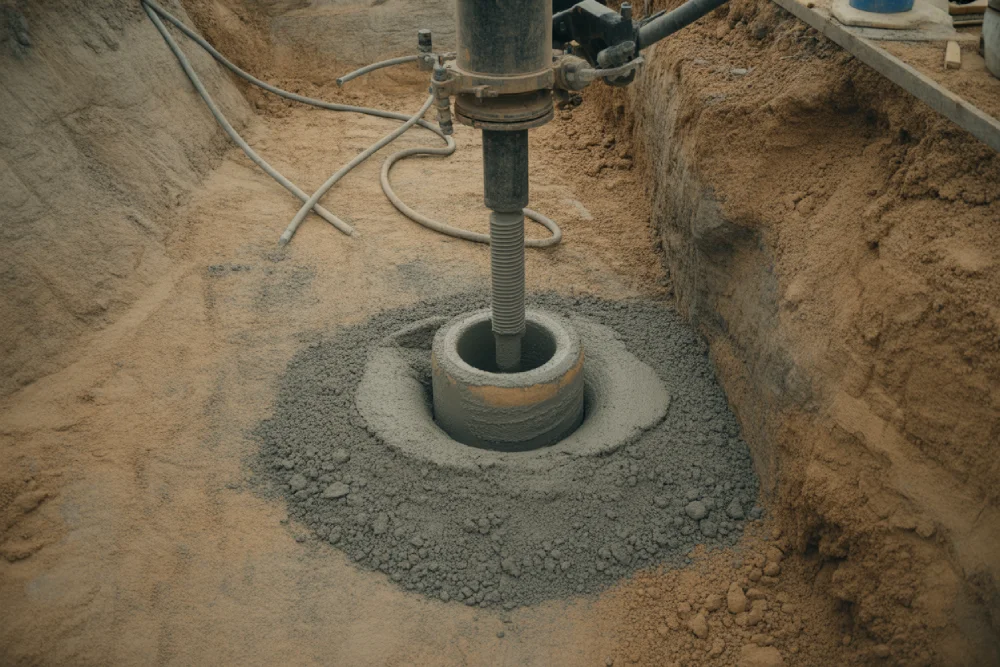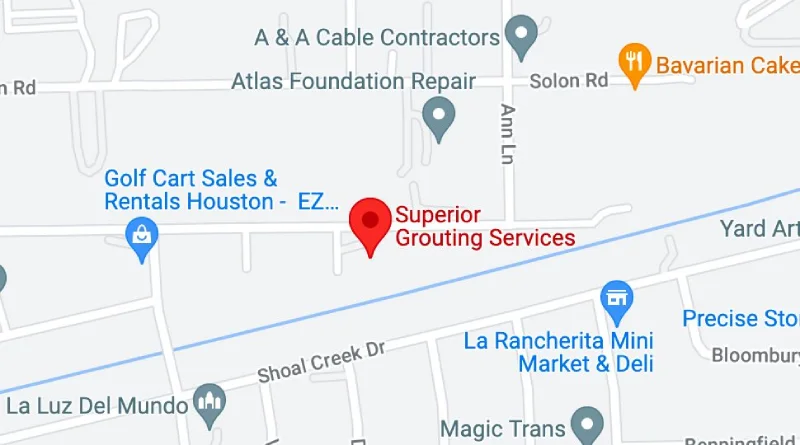Annular Grouting for Soil Stabilization in Weak Ground

Annular grouting stabilizes weak ground by filling the void between casings and surrounding soil with specialized grout, preventing ground movement, improving load-bearing capacity, and blocking water infiltration that causes erosion and settlement.
Weak ground conditions pose significant challenges for construction projects involving foundations, tunnels, and underground utilities. Loose soil, high permeability, and poor bearing capacity threaten structural integrity and long-term performance. When these conditions exist around pipes, casings, or foundation elements, the annular space between the structure and soil becomes a pathway for water infiltration and ground movement.
Annular grouting addresses these challenges by filling this critical void with specialized grout materials under controlled pressure. The process transforms weak, unstable ground into a solid, load-bearing mass that supports structures and prevents settlement. For infrastructure projects requiring reliable soil stabilization, professional pressure grouting services deliver the technical expertise and proven methods needed for lasting results.
Key Takeaways
- Annular grouting fills voids between casings and surrounding soil, creating a solid mass that enhances soil strength, increases bearing capacity, and prevents ground movement in weak or permeable conditions.
- The technique prevents water infiltration and soil erosion around structural elements by sealing pathways that allow groundwater flow, protecting foundations and underground structures from settlement and damage caused by water ingress.
- Cement-based grouts are commonly used for their high compressive strength and durability, though material selection depends on soil conditions, void size, required set time, and specific project performance requirements.
- Tube-à-Manchette grouting is a specialized variation that injects grout through perforated pipes in boreholes, allowing precise targeting of weak zones with controlled pressure for tunneling, slopes, and foundation reinforcement applications.
- Pressure management during injection is critical to achieve complete void filling without causing soil displacement or structural damage, requiring real-time monitoring and adjustment based on geotechnical conditions and soil response.
- Applications span foundation support, tunnel construction, slope stabilization, and groundwater control where weak ground conditions require enhanced stability, reduced permeability, and long-term structural protection against settlement and water-related damage.
Understanding Weak Ground Conditions
Weak ground encompasses various soil and geological conditions that lack the strength or stability needed to support structures effectively. Recognizing these conditions helps determine when annular grouting becomes necessary.
Characteristics of Weak Ground
Several factors contribute to weak ground conditions:
- Low density soils: Loose sand, silt, or recently placed fill materials with large void spaces
- High water content: Saturated soils with reduced shear strength and bearing capacity
- Organic materials: Peat or organic-rich soils that compress under load
- Weathered rock: Decomposed or fractured rock formations with reduced integrity
- Collapsible soils: Materials that densify suddenly when wetted or loaded
These conditions create instability around underground structures and foundation elements, making soil improvement essential for safe construction.
Risks Without Proper Stabilization
Weak ground left untreated leads to predictable problems:
- Excessive settlement causing structural damage and operational disruptions
- Differential movement creating cracks in buildings and infrastructure
- Water infiltration accelerating erosion and void formation
- Loss of bearing capacity requiring costly repairs or reconstruction
- Safety hazards from unexpected ground collapse or structure failure
Annular grouting prevents these outcomes by addressing weak ground conditions before they compromise structural integrity.
How Annular Grouting Stabilizes Weak Ground
The stabilization process combines material science, pressure control, and geotechnical engineering principles to transform weak soil into competent ground.
The Stabilization Mechanism
Annular grouting achieves stabilization through multiple simultaneous actions. The injected grout fills voids between soil particles and the structural element, creating a continuous solid mass. As the grout penetrates into surrounding soil, it binds loose particles together through mechanical interlocking and chemical bonding.
This process increases soil density by displacing air and water from void spaces. The hardened grout forms a rigid skeleton that transfers loads from the structure to competent soil or rock beyond the treated zone. Water pathways are eliminated, preventing the erosion and softening that weaken untreated soil.
Grout Materials for Soil Stabilization
Material selection determines stabilization effectiveness and long-term performance. The table below compares common grout types used in weak ground applications:
| Grout Type | Compressive Strength | Best Applications | Key Advantages | Typical Cost Range |
| Neat Cement | 3,000-5,000 psi | Large voids, permanent structures | Maximum strength, proven durability | $ |
| Cement-Sand Mix | 2,000-4,000 psi | Medium to large voids, cost-sensitive projects | Good strength, economical for volume | $ |
| Microfine Cement | 1,500-3,000 psi | Fine soils, tight spaces | Penetrates small voids, low viscosity | $$ |
| Chemical Grouts | 500-1,500 psi | Active water flow, emergency stabilization | Rapid set, water-reactive | $$$ |
Cement-based grouts dominate soil stabilization applications due to their high strength, availability, and cost-effectiveness. Their performance in weak ground has been proven across thousands of projects over many decades.
Pressure Control and Injection Techniques
Proper pressure management separates successful grouting from attempts that damage soil or waste material. Technicians must balance several competing factors during injection.
Too little pressure results in incomplete void filling, leaving weak zones that compromise stabilization. Excessive pressure can fracture soil, create new pathways for water infiltration, or lift structures above their design elevation. The optimal pressure depends on:
- Soil type and overburden pressure
- Depth of injection below surface
- Grout viscosity and flow characteristics
- Proximity to existing structures
- Presence of groundwater and hydrostatic pressure
Advanced monitoring equipment tracks injection pressure, flow rate, and volume in real time. Experienced operators adjust parameters continuously based on soil response, ensuring complete filling without causing damage.
Tube-à-Manchette Grouting for Targeted Stabilization
Tube-à-Manchette (TAM) grouting represents a specialized approach that enhances precision and control in weak ground treatment. This technique works alongside standard annular grouting to address specific stabilization challenges.
TAM System Components and Operation
The TAM system consists of perforated pipes installed in pre-drilled boreholes throughout the treatment zone. Rubber sleeves (manchettes) cover the perforations, creating one-way valves that open under injection pressure. A double packer assembly seals specific sections of the pipe, directing grout through selected ports into targeted weak zones.
This selective injection allows treatment of specific soil layers or problem areas without grouting the entire borehole. Multiple injection stages at different elevations create a comprehensive stabilization network that addresses all weak zones while minimizing grout consumption and cost.
Applications Where TAM Excels
TAM grouting proves particularly effective in several scenarios:
- Tunneling projects: Pre-treatment of weak zones ahead of excavation prevents face collapse and controls groundwater
- Foundation reinforcement: Targeted strengthening beneath existing structures without major excavation or disruption
- Slope stabilization: Injection into sliding layers or weak seams that cause instability
- Groundwater sealing: Precise placement in water-bearing zones to reduce permeability and control flow
The technique's precision makes it valuable when standard grouting methods cannot adequately target specific problem areas or when adjacent areas must remain undisturbed.
Advantages Over Conventional Methods
TAM grouting offers several benefits for weak ground stabilization:
- Repeatable injections through the same pipe allow progressive treatment as conditions require
- Precise targeting minimizes grout waste and reduces project costs
- Multiple elevation stages treat varied soil conditions within a single borehole
- Controlled pressure prevents soil displacement while ensuring adequate penetration
- Verification testing through the same ports confirms stabilization effectiveness
These advantages make TAM grouting an efficient choice for complex weak ground conditions where standard approaches fall short.
Benefits of Annular Grouting in Weak Ground
Understanding the specific improvements annular grouting delivers helps project planners evaluate its value for their applications.
Enhanced Soil Stability
The primary benefit is transformation of weak, compressible soil into stable ground that resists movement. Grout fills voids and binds particles, creating a coherent mass that maintains its position under load. This stability extends beyond the immediate annular space to strengthen surrounding soil through penetration and densification.
Structures supported by stabilized ground experience uniform bearing conditions rather than differential support that causes cracking and distortion. The improved stability lasts for decades with minimal maintenance, providing reliable long-term performance.
Increased Load-Bearing Capacity
Weak ground often cannot support design loads without excessive settlement or failure. Annular grouting increases bearing capacity by filling voids, increasing soil density, and creating a more rigid structure that distributes loads effectively.
The improvement allows:
- Construction of heavier structures than original soil could support
- Reduction in foundation size and cost for equivalent load capacity
- Elimination of deep foundation systems in favor of shallow foundations
- Support for additional loads from facility expansions or equipment upgrades
This increased capacity often provides the margin needed to make projects feasible on sites with challenging ground conditions.
Reduced Settlement Risk
Settlement occurs when soil compresses under structural loads or when water washes away supporting material. Both mechanisms threaten structural integrity and operational functionality. Annular grouting addresses settlement from multiple angles.
The grout fills existing voids that would otherwise allow compression. It prevents water infiltration that causes erosion and loss of support. The stabilized soil mass resists consolidation under load, maintaining its volume and supporting structures at design elevations.
Reduced settlement protects:
- Building foundations from cracking and structural damage
- Utility lines from breaks and service interruptions
- Pavement and slabs from uneven surfaces and drainage problems
- Equipment and machinery from misalignment and operational issues
Water Infiltration Prevention
Water is often the primary cause of weak ground problems. It reduces soil strength, carries away particles, creates hydrostatic pressure, and accelerates deterioration. Blocking water pathways preserves soil stability and prevents progressive weakening.
The grouted annular space forms a continuous barrier that groundwater cannot penetrate. This protection maintains soil strength by keeping water content constant. It prevents erosion by eliminating flow pathways. It reduces hydrostatic pressure on structures by controlling water accumulation.
For projects in high-water environments or areas with seasonal water table fluctuations, this waterproofing function is as important as the mechanical stabilization the grout provides.
Applications Across Infrastructure Types
Different infrastructure categories face unique weak ground challenges that annular grouting addresses effectively.
Foundation Support and Underpinning
Existing structures on weak ground often require foundation strengthening to prevent ongoing settlement or to support additional loads. Annular grouting around foundation elements provides this reinforcement with minimal disruption to operations.
The technique works for:
- Building foundations showing signs of settlement or distress
- Utility structures requiring increased capacity for heavier equipment
- Bridge piers and abutments in compressible soils
- Industrial facilities adding new machinery or storage tanks
Grouting can occur from inside basements or from exterior access points, allowing work to continue while stabilization progresses. The rapid strength gain of cement grouts means foundations can carry increased loads within days of treatment.
Tunnel and Shaft Construction
Tunnel boring and shaft excavation in weak ground create large temporary openings that must be stabilized quickly. The annular space between tunnel linings or shaft casings and excavated soil presents both a challenge and an opportunity.
Without proper treatment, this space allows ground movement that can collapse tunnels or damage surface structures. Annular grouting immediately after lining installation prevents these problems by filling voids and stabilizing surrounding ground.
The stabilization:
- Prevents surface settlement above tunnels and shafts
- Eliminates water infiltration that could flood underground spaces
- Provides long-term support that maintains alignment and prevents deformation
- Protects adjacent utilities and foundations from excavation impacts
Slope and Embankment Stabilization
Slopes in weak soil or weathered rock frequently experience movement that threatens roads, railways, and structures. Annular grouting through installed anchor elements or drainage pipes stabilizes these slopes by improving soil strength and reducing water content.
The technique is particularly effective for:
- Highway and railway embankments showing signs of instability
- Dam and levee slopes requiring reinforcement
- Excavation support where temporary slopes must remain stable
- Landslide repair where previous movement has created weak zones
Grouting can target specific failure planes or treat entire slope masses, depending on conditions and stability requirements. The treatment often combines with other measures like drainage improvements and mechanical reinforcement for comprehensive slope protection.
Water Infrastructure Projects
Dams, levees, water treatment plants, and pump stations operate in constant contact with water, making weak ground stabilization critical for safety and performance. Annular grouting around conduits, valve chambers, and structural foundations prevents the water-driven soil degradation that threatens these facilities.
Applications include:
- Seepage control around conduits through dam embankments
- Foundation stabilization for pump stations and treatment facilities
- Void filling behind retaining walls and floodwalls
- Groundwater cutoff barriers protecting excavations
The durability of cement-based grouts in wet environments makes them ideal for these long-service-life applications where performance must remain consistent for 50 to 100 years.
Quality Assurance and Verification
Confirming that annular grouting achieved its stabilization objectives requires systematic testing and documentation.
Pre-Treatment Assessment
Before grouting begins, engineers must document existing conditions to establish a baseline for comparison. This assessment includes:
- Subsurface exploration identifying weak zones and soil properties
- Groundwater monitoring showing levels and flow patterns
- Structural surveys documenting settlement or distress
- Laboratory testing determining soil strength and permeability
This information guides grouting design and provides reference values for evaluating improvement after treatment.
During-Injection Monitoring
Real-time monitoring during grouting operations provides immediate feedback on treatment effectiveness. The table below shows critical parameters and their significance:
| Monitored Parameter | What It Indicates | Action Thresholds |
| Injection Pressure | Soil acceptance and void filling | Sudden drops indicate grout breakthrough; spikes suggest blockage |
| Flow Rate | Grout movement through soil | Decreasing rates show void filling progress; zero flow requires investigation |
| Grout Volume | Total material placed vs. calculated void volume | Volumes exceeding 150% of calculated voids suggest soil fracturing |
| Refusal Pressure | Point where soil no longer accepts grout | Reaching design pressure confirms adequate treatment |
Experienced operators interpret these parameters continuously, adjusting procedures to achieve complete stabilization while avoiding problems.
Post-Treatment Verification
After grouting concludes and grout has cured, verification testing confirms that stabilization objectives were met:
- Core drilling through grouted zones shows penetration and fill quality
- Standard penetration testing demonstrates improved soil strength
- Permeability testing confirms reduced water infiltration
- Settlement monitoring tracks ground stability over time
- Load testing on foundations verifies increased capacity
Documentation of these results provides proof that weak ground has been transformed into competent soil capable of supporting design loads safely.
Selecting a Qualified Grouting Contractor
The contractor's expertise determines whether annular grouting successfully stabilizes weak ground or creates new problems through improper execution.
Technical Qualifications to Verify
Look for contractors with specific capabilities relevant to weak ground stabilization:
- Licensed professional engineers experienced in geotechnical grouting design
- Field personnel trained in pressure grouting techniques and equipment operation
- Quality control systems ensuring consistent grout properties and placement procedures
- Testing capabilities for both pre-grouting assessment and post-treatment verification
These qualifications indicate the contractor understands the technical complexities of weak ground stabilization and can adapt to site-specific challenges.
Experience With Similar Conditions
Weak ground varies significantly in its characteristics and response to treatment. Contractors should demonstrate experience with soil types and conditions similar to your project:
- Loose granular soils requiring void filling and densification
- Soft clays needing increased shear strength
- Weathered rock with variable properties and water flow
- High-water conditions requiring specialized materials or procedures
This experience means they have encountered and solved problems similar to those your project will present.
Project Communication and Management
Successful weak ground stabilization requires close coordination between the contractor, design engineer, and project owner. Evaluate contractors on their communication practices:
- Clear explanations of proposed methods and expected outcomes
- Regular progress reports with monitoring data and observations
- Prompt notification of unexpected conditions requiring design adjustments
- Comprehensive final documentation including as-built information and test results
Good communication ensures everyone understands what is happening and can make informed decisions when conditions differ from initial assumptions.
Safety and Environmental Compliance
Grouting operations involve pressure equipment, chemical materials, and work in potentially unstable ground. Contractors must demonstrate commitment to safety through:
- Written safety programs addressing grouting-specific hazards
- Equipment inspection and maintenance procedures
- Personnel training and certification
- Environmental controls preventing grout spills or impacts to groundwater
A strong safety record indicates the contractor takes these responsibilities seriously and will execute work without incidents that delay projects or create liability.
For weak ground stabilization projects where soil conditions threaten structural safety and performance, contact experienced grouting specialists who deliver reliable results through proven methods and technical expertise.
Conclusion
Annular grouting stabilizes weak ground by filling voids around structural elements with specialized grout materials that increase soil strength, improve bearing capacity, and prevent water infiltration. The technique transforms unstable soil into competent ground capable of supporting foundations, tunnels, and infrastructure safely and reliably.
Success requires proper material selection, pressure-controlled injection, and comprehensive quality assurance to confirm stabilization objectives are achieved. Specialized techniques like Tube-à-Manchette grouting provide targeted treatment for complex weak ground conditions where precision is essential.
For infrastructure projects on challenging sites, annular grouting offers a proven solution that delivers lasting soil stabilization and structural protection at reasonable cost with minimal disruption to surrounding areas and operations.

